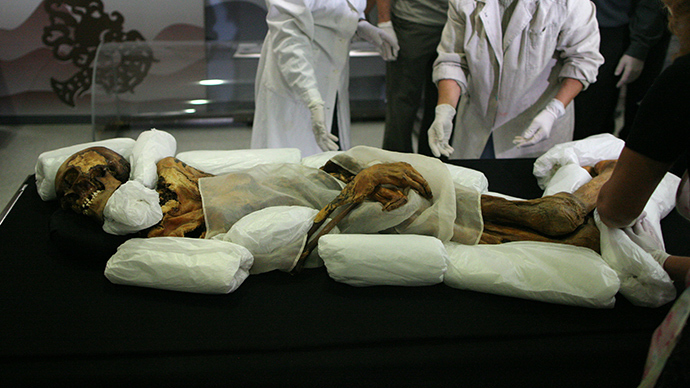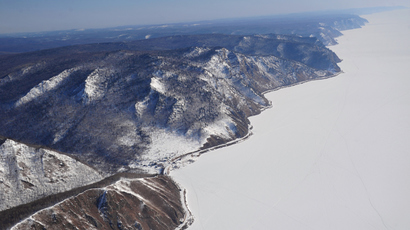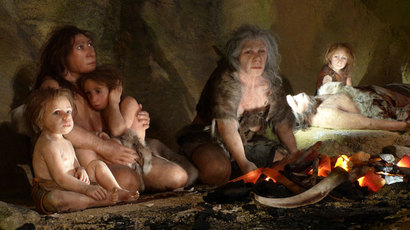MRI reveals ancient Siberian ‘princess’ had breast cancer

Brand new MRI scans have revealed that a 2,500-year-old ancient Pazyryk 'princess' died from the same disease that over a million women are fighting today: breast cancer. Scientists believe the young woman could have used cannabis to ease the pain.
The discovery of the mummified remains of the so-called Princess Ukok in 1993 in a permafrost subterranean tomb in the Altai Mountains – close the borders of Kazakhstan, China, and Mongolia – was arguably the most significant Russian archaeological finding of the late 20th century.
Read More:Scientists revive giant virus from 30,000-year-old Siberian permafrost
Since then, her remains have been undergoing exams at the
research facility in Novosibirsk to include facial
reconstruction, DNA tests, and other research projects. She has
been linked to the nomadic Pazyryk culture that inhabited the
plateau about 5th Century BC.
Scientists knew she was young since she died at the age of 25,
but only recently did they discover what probably caused her
death.
Using MRI scanners, scientists detected asymmetrical signals in
the mummy.
“During the imaging of mammary glands, we paid attention to
their asymmetric structure and the varying asymmetry of the MRI
signal. We are dealing with a primary tumor in the right breast
and right axial lymph nodes with metastases,” Dr. Andrey
Letyagin of the Institute of Physiology and Fundamental Medicine
told The Siberian Times.
Letyagin worked with Dr. Andrey Savelov of the International
Tomography Center, and together their findings were recently
published in Science First Hand journal.
The mysterious woman in question was a little over 20 years old
when she developed breast cancer, which destroyed her over five
years later, Letyagin told the journal.
“The three first thoracic vertebrae showed a statistically
significant decrease in MR signal and distortion of the contours,
which may indicate the metastatic cancer process,” he added.
“I am quite sure of the diagnosis - she had cancer. She was
extremely emaciated. Given her rather high rank in society and
the information scientists obtained studying mummies of elite
Pazyryks, I do not have any other explanation of her state. Only
cancer could have such an impact.”
“It is clearly seen the tumor in her right breast, visible is
the metastatic lesion of the lymph node and spine…She had cancer
and it was killing her,” said Letyagin.

Still, Letyagin said it is hard to know if cancer was the direct
cause of her death because he could also see traces of trauma in
her bones – dislocations of joints, fractures of the skull – as
if she fell from a high surface.
Cancer has been documented to have existed since ancient Egypt,
and when the circumstances are conducive, MRIs are being used for
further understanding. Dr. Mislav Carka, a medical doctor at the
University of Zagreb, used an MRI on a 29,000-year-old male mummy
and detected a rare form of cancer.
Read More:Bone mystery: Did ancient humans have sex with other species than Neanderthals?
Letyagin and Savelov said the MRI showed the princess also
suffered from osteomyelitis, an infection of the bone or bone
marrow, from childhood or adolescence.
But how did the young princess cope with what must have been
excruciating pain? Dr. Natalia Polosmak, the archeologist who
found the remarkable human remains in 1993, said she likely used
some analgesics.
“In ancient cultures, from which there is a written
testimony, such analgesics used were wine, hashish, opium,
henbane, and extract of mandrake, aconite and Indian hemp. The
Pazyryks knew hemp and its features,” she said.
In fact, the princess’ chamber did contain cannabis.
“Probably for this sick woman, sniffing cannabis was a forced
necessity,” said Polosmak. “And she was often in an
altered state of mind. We can suggest that through her the
ancestral spirits and gods could speak.”
Though she is often referred to as a princess, the archaeologist thinks the woman might have been a shaman, as her remains were discovered in a tumuli or Kurgan, and buried in a similar style reserved usually for royalty.
The excavation and study of the woman's remains have been surrounded by controversy locally, as some Altay elders believe that disturbing her tomb has angered her spirit and caused natural disasters.
Read More:Siberian elders vote to bury 2,500yo mummy to stop quakes, floods














